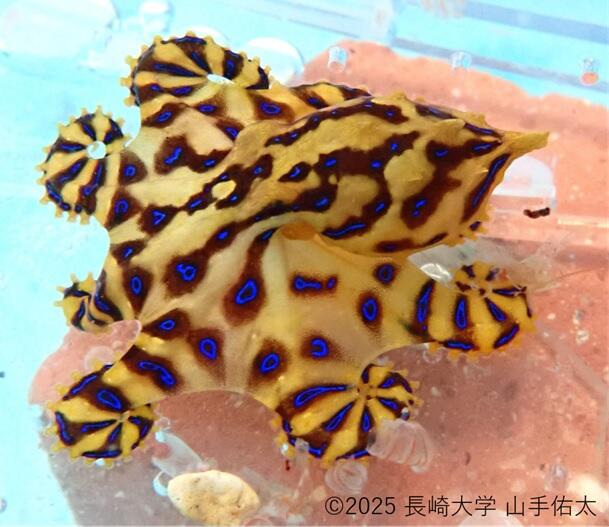The Japanese blue-lined octopus (Hapalochlaena cf. fasciata) is known to have large quantities of the deadly poison tetrodotoxin (TTX) mainly in its posterior salivary glands, the venom glands of the octopus, and in the muscles and skin throughout its body. The posterior salivary glands store high concentrations of TTX, which is injected into target organisms after biting them for predation and defense against predators. TTX is a very potent toxin, and people have died in Australia after being bitten by a species closely related to the Japanese blue-lined octopus in accidents. Meanwhile, TTX in the muscle and skin has been speculated to be used for defense against predators, as is the case for pufferfish, but it was not clear how it is actually used.
Assistant Professor Yuta Yamate of the Institute of Integrated Science and Technology (Fisheries), Professor Tomohiro Takatani and Associate Professor Takeshi Takegaki of the Graduate School of Integrated Science and Technology at Nagasaki University, and their colleagues have revealed that the Japanese blue-lined octopus releases TTX from its muscle and skin in the presence of predators. The octopus is known to bite both prey and predators, injecting TTX to paralyze them. In this study, they discovered that the octopus uses the toxin in another way, i.e., releasing TTX from the body surface. The study was published in Molluscan Research.

Provided by Nagasaki University
When a Japanese blue-lined octopus and a moray eel were housed in a tank and separated from each other by a transparent acrylic plate with small holes for 3 days, the TTX concentration in the muscle and skin of the Japanese blue-lined octopus was found to decrease by about 30%. In contrast, an individual housed in the same environment without moray eel presentation showed no decrease in TTX concentration. The TTX concentration in the mucus on the body surface was measured in four replicated experiments with and without moray eel presentation across a transparent acrylic plate with small holes. The results showed that TTX was detected only in the mucus immediately after moray eel presentation, and TTX was not detected in the mucus without moray eel presentation. These two experiments revealed that the blue-lined octopus releases TTX along with mucus from its muscles and skin in response to the presence of predators, leading to the depletion of TTX in its muscles and skin.
There are two important points to these experiments. First, in both experiments, the Japanese blue-lined octopus and the moray eel were not in direct contact, yet TTX release was observed only in the presence of the moray eel. This result indicates that the octopus spontaneously releases TTX when it simply detects the presence of a predator through visual or olfactory sensation, even if it is not directly attacked. Second, TTX in the mucus was detected only when a predator was presented but not detected without predator presentation. This finding indicates that the octopus selectively releases TTX as needed. Furthermore, when it recognizes the presence of a predator, it secretes TTX from the muscle and skin into the mucus on the body surface, and the amount of TTX in the muscle and skin is thereby reduced.
Journal Information
Publication: Molluscan Research
Title: Verification of tetrodotoxin utilisation against predators in Japanese blue-lined octopus Hapalochlaena cf. fasciata
DOI: 10.1080/13235818.2024.2441955
This article has been translated by JST with permission from The Science News Ltd. (https://sci-news.co.jp/). Unauthorized reproduction of the article and photographs is prohibited.




